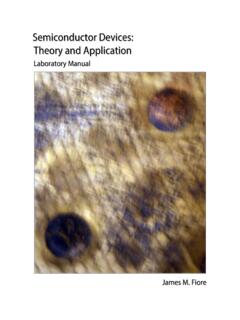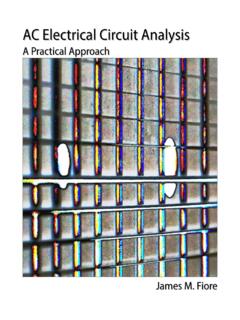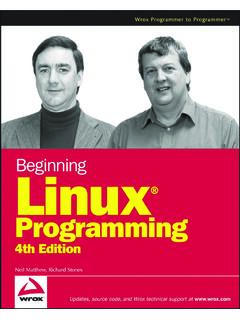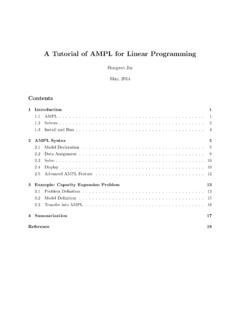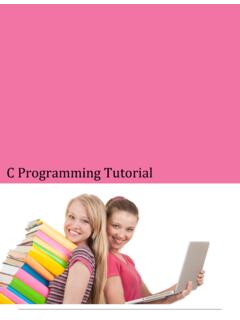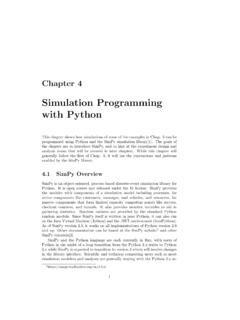Transcription of Laboratory Manual for Computer Programming with …
1 Computer ProgrammingComputer Programmingwith Pythonwith Python , MultisimMultisim & TINA & TINA / / 4E4 ELaboratory ManualLaboratory ManualJames M. FioreJames M. FioreLaboratory Manual for Computer Programming 2 Laboratory Manual forComputer Programmingwith Python , Multisim & TINA , Fourth EditionbyJames M. FioreVersion , 23 July 2020 Laboratory Manual for Computer Programming3 This Laboratory Manual for Computer Programming with Python , Multisim & TINA /4E, by James M. Fiore is copyrighted under the terms of a Creative Commons license: This work is freely redistributable for non-commercial use, share-alike with attributionPublished by James M.
2 Fiore via dissidents ISBN13: 979-8654193452 For more information or feedback, contact:James Fiore, ProfessorElectrical Engineering TechnologyMohawk Valley Community College1101 Sherman DriveUtica, NY the latest revisions, related titles, and links to low cost print versions, go to: or my mirror sites and Channel: Electronics with Professor FioreMultisim is a trademark of National Instruments. TINA is a trademark of DesignSoft. Neither the author, nor any software programs or other goods or services offered by the author, are affiliated with, endorsed by, or sponsored by National Instruments or art, Squarer for Bear, by the authorLaboratory Manual for Computer Programming 4 IntroductionThis Laboratory Manual is intended for use in an introductory Computer Programming course for electrical engineering technology students.
3 It begins with a basic explanation of schematic capture and simulation tools and proceeds to the Python Programming language. Python (version ) was chosen for several reasons. First, it is a modern, open-source Programming environment. Second, it has a relatively shallow learning curve meaning that new Programming students can get up and running fairly quickly, yet the language is fairly deep and powerful. It is by no means a toy language. Third, it is free and multi-platform, available for Windows, Mac and linux . This fourth edition is updated to Multisim 14.
4 It also introduces alternate exercises using the TINA simulator from DesignSoft. A free version of TINA, TINA-TI, is available for download on the Texas Instruments web site: Programming applications presented tend to be electrical circuit based although some lean closer to quality control issues and a few are intended strictly as a way of stretching out and having some fun. As the language s designer and developers are fans of Monty Python, it is helpful to at least watch a few of their movies in order to appreciate the embedded jokes.
5 Most of the exercises are designed to be completed in a single practicum period of two or three hours, however, a few are a bit more involved and will require more time (such as Caerbannog and Functions and Files). Other Laboratory manuals in this series include DC and AC Electrical Circuit Analysis, Semiconductor Devices (diodes, bipolar transistors and FETs), Operational Amplifiers and Linear Integrated Circuits, andEmbedded Controllers Using C and Arduino. Texts are also available for DC and AC Electrical Circuit Analysis, Embedded Controllers (second edition), Operational Amplifiers (third edition), and Semiconductor Devices.
6 A Note from the AuthorThis work was borne out of the need to create a lab Manual for the ET154 Computer Programming courseat Mohawk Valley Community College in Utica, NY, part of our ABET accredited AAS program in Electrical Engineering Technology. Another important aspect was to come up with an affordable solution for the students. As both the Programming language and the Manual are free, this much is certainly covered. I am indebted to my students, co-workers and the MVCC family for their support and encouragement of this project.
7 While it would have been possible to seek a traditional publisher for this work, as a long-time supporter and contributor to freeware and shareware Computer software, I have decided instead to release this using a Creative Commons non-commercial, share-alike license. I encourage others to make use of this Manual for their own work and to build upon it. If you do add to this effort, I would appreciate a notification. Without deviation, progress is not possible - Frank ZappaLaboratory Manual for Computer Programming5 Laboratory Manual for Computer Programming 6 Table of Contents1A.
8 Introduction to 81B. Introduction to Multisim TINA 3. Introduction to 4. Obtaining User 5. Conditionals: 6. More 7. Random 8. 9. 10. 11. Functions and Files ..98 Laboratory Manual for Computer Programming71 AIntroduction to Multisim ObjectiveThe objective of this exercise is to become familiar with the Multisim electrical circuit simulation package by National Instruments in order to create simple schematics and perform basic simulations. The differences between virtual, real, and 3D components will be examined along with the use of virtual instruments to make simulated measurements.
9 Please note that the precise look of the windows, menus and dialog boxes may be slightly different from that pictureddepending on the version of Multisim that is being used. Regardless of appearance, the functionality remains. A student edition of Multisim is available at reduced logging into the Computer , open Multisim. If a desktop shortcut is not available Multisim may be accessed via the Programs menu under the NI (National Instruments) menu item. This is a large program and may take a minute or two to load. Eventually, you will be greeted with something similar to the screen shown in Figure 1A-1.
10 As the toolbars are customizable, the precise look of the program may be a little different from that shown. In general, there are a series of toolbars along the top. These are used to select different components and editing or viewing functions. Multisim s schematic capture facility is object based, that is, you draw a circuit by selecting predefined objects such as resistors and transistors, and drag them onto the workspace. They are then wired together using the mouse. You can zoom into or out of the workspace using the mouse. By default, along the left edge is the Design Toolbox browser window.
